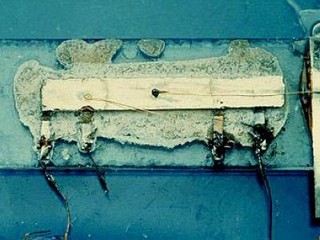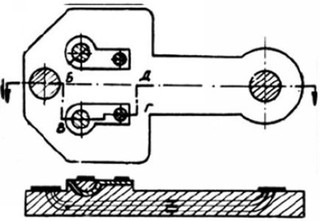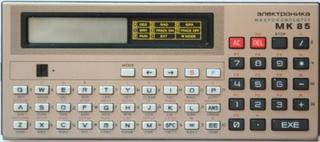Computer Science and Electronics: Forgotten Records
Few people know that the world's first computer, whose performance exceeded 1 million operations per second, was developed in 1960-1963. at the Moscow research institute-37. And the world's first hybrid integrated circuit was created in the USSR ...

The world's first hybrid IC
The development of the world's first hybrid integrated circuit was made in 1963 at the Leningrad Research Institute of Radio Electronics. It was the first GIS in the world with two-level integration, and as the active elements it was used not discrete frameless transistors, but the world's third semiconductor IC “P12-2”, designed and manufactured in 1962. It was also a multi-element product that was functionally finished delivered to the consumer as an independent product. GIS was produced until the mid-1990s, i.e. more than 30 years.

What about them ? The first foreign GIS was announced by IBM in 1964 in the form of STL modules that were created for the new family of IBM-360 computers.
The world's first computer millionaire
The first computer in the world whose performance exceeded 1 million operations per second was developed in 1960-1963. at the Moscow research institute-37. This is an experimental computer of the second generation (on discrete transistors) T340-A with a productivity of 2.4 million operations per second. On its basis, a serial computer K340-A was developed, released by the industry in the amount of 50 sets. High computer performance was achieved through the use of modular arithmetic. T340-A and K340-A remain world record holders for performance among second-generation computers. And these were the computers with the lowest cost per unit of productivity - 25 kopecks. per operation per second.

Especially curious is the fact that, thanks to their high reliability and unique characteristics, K-340A computers are still in operation!
The world's first computer of the 3rd generation.
The world's first computer of the 3rd generation (a computer made on the basis of integrated circuits - ICs) was developed in 1963-64. at the Leningrad Research Institute of Radioelectronics. This is the Gnom on-board computer, created on the basis of the world's first hybrid quantum integrated circuits developed by NIIRE Kvant (later GIS Series 116). IL-76 with the modification of the Gnome-1 in the image.

What about them?There are references to earlier 3rd generation computers, which were allegedly made in 1961 by the Texas company. However, the information is not considered reliable, since the company that posted this information did not have the appropriate profile and later did not confirm its development.
The world's first 16-bit home computer
The world's first 16-bit consumer computer, Electronics NTs-8010, was developed at the Zelenograd Scientific Research Institute of Precise Technology. The computer was created on the basis of the original 16-bit single-chip microcomputer "Electronics NTs-80T" with the original architecture and the command system "Electronics NTs", with a clock frequency of 8 MHz. After several modifications, the household computer began to be manufactured by the Exciton factory (Pavlovsky Posad, Moscow Region) under the name Electronics BK-0010, which is considered the world's first serial 16-bit household computer.

What about them? Foreign home computers of those years were produced on the basis of 8-bit microprocessors of types I 8080 (Intel), Z-80 (Zilog) and 6501 (MOS Technology) with a clock frequency of 1 MHz.
The world's first 16-bit PDA
The world's first 16-bit handheld personal computer (PDA) "Electronics MK-85" with microprogram implementation of the programming language Basic was developed at the Zelenograd Scientific Research Institute of Precise Technology in 1985. The PDA is built on the basis of a special original 16-bit microprocessor KA1013BM1, software compatible with personal computers like DVK and BK-0010 with PDP-11 compatible architecture. It was produced by the Angstrem factory from 1986 to 2000.

What about them? The few foreign PDAs of those years were built on the basis of 4- or 8-bit microprocessors.

The world's first hybrid IC
The development of the world's first hybrid integrated circuit was made in 1963 at the Leningrad Research Institute of Radio Electronics. It was the first GIS in the world with two-level integration, and as the active elements it was used not discrete frameless transistors, but the world's third semiconductor IC “P12-2”, designed and manufactured in 1962. It was also a multi-element product that was functionally finished delivered to the consumer as an independent product. GIS was produced until the mid-1990s, i.e. more than 30 years.

What about them ? The first foreign GIS was announced by IBM in 1964 in the form of STL modules that were created for the new family of IBM-360 computers.
The world's first computer millionaire
The first computer in the world whose performance exceeded 1 million operations per second was developed in 1960-1963. at the Moscow research institute-37. This is an experimental computer of the second generation (on discrete transistors) T340-A with a productivity of 2.4 million operations per second. On its basis, a serial computer K340-A was developed, released by the industry in the amount of 50 sets. High computer performance was achieved through the use of modular arithmetic. T340-A and K340-A remain world record holders for performance among second-generation computers. And these were the computers with the lowest cost per unit of productivity - 25 kopecks. per operation per second.

Especially curious is the fact that, thanks to their high reliability and unique characteristics, K-340A computers are still in operation!
The world's first computer of the 3rd generation.
The world's first computer of the 3rd generation (a computer made on the basis of integrated circuits - ICs) was developed in 1963-64. at the Leningrad Research Institute of Radioelectronics. This is the Gnom on-board computer, created on the basis of the world's first hybrid quantum integrated circuits developed by NIIRE Kvant (later GIS Series 116). IL-76 with the modification of the Gnome-1 in the image.

What about them?There are references to earlier 3rd generation computers, which were allegedly made in 1961 by the Texas company. However, the information is not considered reliable, since the company that posted this information did not have the appropriate profile and later did not confirm its development.
The world's first 16-bit home computer
The world's first 16-bit consumer computer, Electronics NTs-8010, was developed at the Zelenograd Scientific Research Institute of Precise Technology. The computer was created on the basis of the original 16-bit single-chip microcomputer "Electronics NTs-80T" with the original architecture and the command system "Electronics NTs", with a clock frequency of 8 MHz. After several modifications, the household computer began to be manufactured by the Exciton factory (Pavlovsky Posad, Moscow Region) under the name Electronics BK-0010, which is considered the world's first serial 16-bit household computer.

What about them? Foreign home computers of those years were produced on the basis of 8-bit microprocessors of types I 8080 (Intel), Z-80 (Zilog) and 6501 (MOS Technology) with a clock frequency of 1 MHz.
The world's first 16-bit PDA
The world's first 16-bit handheld personal computer (PDA) "Electronics MK-85" with microprogram implementation of the programming language Basic was developed at the Zelenograd Scientific Research Institute of Precise Technology in 1985. The PDA is built on the basis of a special original 16-bit microprocessor KA1013BM1, software compatible with personal computers like DVK and BK-0010 with PDP-11 compatible architecture. It was produced by the Angstrem factory from 1986 to 2000.

What about them? The few foreign PDAs of those years were built on the basis of 4- or 8-bit microprocessors.
